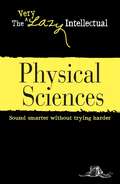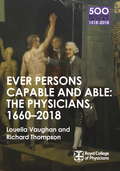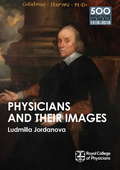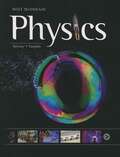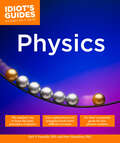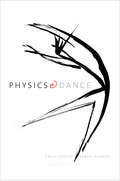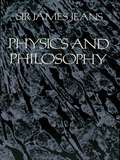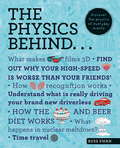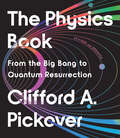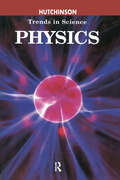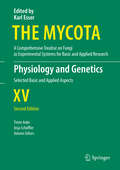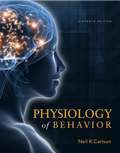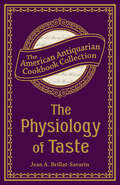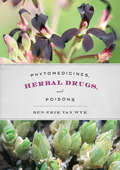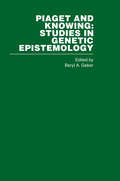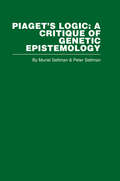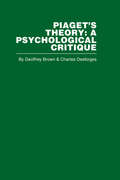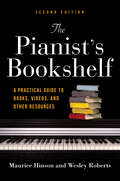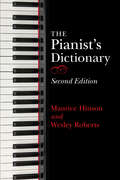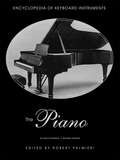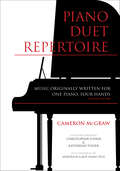- Table View
- List View
Physical Sciences: Sound smarter without trying harder (The Very Lazy Intellectual)
by Adams MediaDid you avoid all but the easiest science courses in school? Wish you knew what the theory of relativity refers to? Fear not! Covering everything from earth sciences to astrophysics, The Very Lazy Intellectual: Physical Sciences introduces you to the world's most important scientific theories. With information on the Big Bang to the Manhattan Project, you'll learn just enough to hold your own in conversation.
The Physicians 1660-2018: Ever Persons Capable and Able
by Richard Thompson Louella VaughanThe Royal College of Physicians celebrates its 500th anniversary in 2018, and to observe this landmark is publishing this series of ten books. Each of the books focuses on fifty themed elements that have contributed to making the RCP what it is today, together adding up to 500 reflections on 500 years. Some of the people, ideas, objects and manuscripts featured are directly connected to the College, while others have had an influence that can still be felt in its work.This, the seventh book in the series looks at the history of the Royal College.
The Physicians 1660-2018: Ever Persons Capable and Able (500 Reflections on the RCP, 1518-2018 #7)
by Louella Vaughan Richard ThompsonThe Royal College of Physicians celebrates its 500th anniversary in 2018, and to observe this landmark is publishing this series of ten books. Each of the books focuses on fifty themed elements that have contributed to making the RCP what it is today, together adding up to 500 reflections on 500 years. Some of the people, ideas, objects and manuscripts featured are directly connected to the College, while others have had an influence that can still be felt in its work.This, the seventh book in the series looks at the history of the Royal College.
Physicians and their Images
by Ludmilla JordanovaThe Royal College of Physicians celebrates its 500th anniversary in 2018, and to observe this landmark is publishing this series of ten books. Each of the books focuses on fifty themed elements that have contributed to making the RCP what it is today, together adding up to 500 reflections on 500 years. Some of the people, ideas, objects and manuscripts featured are directly connected to the College, while others have had an influence that can still be felt in its work.This, the eighth book in the series looks at the art and portraits of the Royal College.
Physics (Idiot's Guides)
by Paul V. Pancella Marc HumphreyPhysics can be a complex and intimidating subject. Idiot's Guides: Physics breaks down the complex topics of physics and makes them easy to understand. Readers will learn from numerous examples and problems that teach all of the fundamentals — Newton's Laws, thermodynamics, mass, energy and work, inertia, velocity and acceleration, and more!
Physics and Dance
by Emily Coates Sarah DemersA fascinating exploration of our reality through the eyes of a physicist and a dancer—and an engaging introduction to both disciplines From stepping out of our beds each morning to admiring the stars at night, we live in a world of motion, energy, space, and time. How do we understand the phenomena that shape our experience? How do we make sense of our physical realities? Two guides—a former member of New York City Ballet, Emily Coates, and a CERN particle physicist, Sarah Demers—show us how their respective disciplines can help us to understand both the quotidian and the deepest questions about the universe. Requiring no previous knowledge of dance or physics, this introduction covers the fundamentals while revealing how a dialogue between art and science can enrich our appreciation of both. Readers will come away with a broad cultural knowledge of Newtonian to quantum mechanics and classical to contemporary dance. Including problem sets and choreographic exercises to solidify understanding, this book will be of interest to anyone curious about physics or dance.
Physics and Philosophy
by James JeansCan we have any knowledge of the world outside us other than we gain by the methods of science? Are we humans endowed with free will, or are we mere cogs in a vast machine that must follow its predestined course until it finally runs down? Is the world we perceive the world of ultimate reality, or is it only a curtain veiling a deeper reality beyond?In this strikingly lucid and often poetic book, one of the twentieth century's greatest scientists grapples with these age-old questions, achieving in the process a brilliant and non-technical exposition of the interrelationship between physics and philosophy. He begins by defining physics and philosophy, pointing out the difference in their respective attempts to explain physical reality and man's place in it. This discussion paves the way for an outline of epistemological methods in which the rationalism of thinkers like Descartes, Leibniz, and Kant is compared to the empiricism of Locke and Hume.Over the course of the book, in a manner that is careful and methodic but never dull, Jeans marshals the evidence for his startling conclusion: recent discoveries in astronomy, mathematics, sub-atomic physics, and other disciplines have washed away the scientific basis of many older philosophic discussions. Such long-standing problems as causality, free will and determinism, the nature of space and time, materialism and mentalism must be considered anew in the light of new knowledge and information attained by twentieth-century physical science. Even then, however, Jeans cautions against drawing any positive conclusions, pointing out that both physics and philosophy are both relatively young and that we are still in Newton's words, like children playing with pebbles on the sea-shore, while the great ocean of truth rolls, unexplored, beyond our reach.Although first published in 1943, nothing in physics has happened to affect Jeans's account in this book; it remains remarkably fresh and undated, a classic exposition of the philosophical implications of scientific knowledge.
The Physics Behind... (The Behind... series)
by Russ SwanCan you really lose weight by consuming nothing but ice cream and beer? How does the latest blockbuster movie get squeezed onto a disk, and how do they make the pictures seem 3D? How much does a selfie weigh? What's the science behind forensic investigations, body scans, and the dating of ancient artefacts?The Physics Behind... takes the reader on a fascinating journey through the scientific principles that that make the modern world work. Could there be life on Mars? Why is north really south? How do self-driving cars find their way around? These and many more topics are explored by starting with the basic science that makes them tick - examining the physics behind them. Packed with detailed original artwork and infographics, The Physics Behind... is perfect for anyone who has ever been curious about the science of life.Including:- The physics behind modern life: Wi-Fi, Facial recognition, touchscreens, microwave ovens, the ice cream and beer diet, taking a selfie, Flash memory, a bag of sugar, catching the train, calendars and clocks- The physics behind entertainment: optical discs, lasers, white water, executive toys, the electric guitar, music, 3D movies- The physics behind analysis: medical imaging, looking at little things, spectroscopy, crime scene investigation, tricorder, microfluidics, radiocarbon dating, proving the Earth is round- The physics behind space: rocket science, space weather, Planet Nine, space telescopes, is there anybody out there? life on Earth, life on Mars- The physics behind big science: what's the matter?, time travel, bomb or meltdown?, the Large Hadron Collider, the Human Genome Project, the Standard Model, gravity, everything- The physics behind the weird universe: strings, rings and other things, N-dimensional space, the hypercube, antimatter, the dark universe, quantum weirdness, quantum biology, time crystals and Majorana- The physics behind the environment: weather forecasts, climate change, renewable energy, migration, peacock feathers, sunburn, rainbows, spider silk- The physics behind transportation: autonomous autos, Hyperloop, Maglev, satellite navigation, motor sport, going rreeaallllyy fast, stealth- The physics behind everything else: curve balls, the Mpemba Effect, why north is really south, perpetual motion and the heat death of the universe, and the physics behind this book.
The Physics Behind...: Discover The Physics Of Everyday Life
by Russ SwanCan you really lose weight by consuming nothing but ice cream and beer? How does the latest blockbuster movie get squeezed onto a disk, and how do they make the pictures seem 3D? How much does a selfie weigh? What's the science behind forensic investigations, body scans, and the dating of ancient artefacts?The Physics Behind... takes the reader on a fascinating journey through the scientific principles that that make the modern world work. Could there be life on Mars? Why is north really south? How do self-driving cars find their way around? These and many more topics are explored by starting with the basic science that makes them tick - examining the physics behind them. Packed with detailed original artwork and infographics, The Physics Behind... is perfect for anyone who has ever been curious about the science of life.Including:- The physics behind modern life: Wi-Fi, Facial recognition, touchscreens, microwave ovens, the ice cream and beer diet, taking a selfie, Flash memory, a bag of sugar, catching the train, calendars and clocks- The physics behind entertainment: optical discs, lasers, white water, executive toys, the electric guitar, music, 3D movies- The physics behind analysis: medical imaging, looking at little things, spectroscopy, crime scene investigation, tricorder, microfluidics, radiocarbon dating, proving the Earth is round- The physics behind space: rocket science, space weather, Planet Nine, space telescopes, is there anybody out there? life on Earth, life on Mars- The physics behind big science: what's the matter?, time travel, bomb or meltdown?, the Large Hadron Collider, the Human Genome Project, the Standard Model, gravity, everything- The physics behind the weird universe: strings, rings and other things, N-dimensional space, the hypercube, antimatter, the dark universe, quantum weirdness, quantum biology, time crystals and Majorana- The physics behind the environment: weather forecasts, climate change, renewable energy, migration, peacock feathers, sunburn, rainbows, spider silk- The physics behind transportation: autonomous autos, Hyperloop, Maglev, satellite navigation, motor sport, going rreeaallllyy fast, stealth- The physics behind everything else: curve balls, the Mpemba Effect, why north is really south, perpetual motion and the heat death of the universe, and the physics behind this book.
The Physics Book: From the Big Bang to Quantum Resurrection (Union Square & Co. Milestones)
by Clifford A. PickoverThis richly illustrated chronology of physics contains more than 250 short, entertaining, and thought-provoking entries. In addition to exploring such engaging topics as dark energy, parallel universes, the Doppler effect, the God particle, and Maxwell's demon, the book's timeline extends back billions of years to the hypothetical Big Bang and forward trillions of years to a time of &“quantum resurrection.&” This reissue includes four new entries: 2012 (Discovery of the Higgs Boson), 2015 (Gravitational Waves), 2019 (First Image of a Black Hole), and 2023 (Milky Way Neutrino Map). It also features an expanded introduction and updates throughout the book.
Physics in Minutes
by Giles SparrowPhysics in Minutes covers everything you need to know about physics, condensed into 200 key topics. Each idea is explained in clear, accessible language, building from the basics, such as mechanics, waves, and particles, to more complex topics, including neutrinos, string theory, and dark matter.Following the latest scientific research proving that the brain best absorbs information visually, each description is accompanied by an illustration to aid quick comprehension and easy recollection. This convenient and compact reference book is ideal for anyone interested in how our world works.Chapters include: Newton's Laws of Motion, Schrodinger's cat, Magnetism, Superconductivity, Fission and fusion, Higgs Boson, Entropy, Dark matter.
Physics Trends (Trends in Science)
by Chris CooperToday's fast-moving world of science will have far-reaching effects on all of our lives. Trends inScience is a series of of essential readings for anyone who wants to know more about how his or her future will be affected; as well, the series provides accessible and stimulating material for high school and college students, for researchers and librarians.All titles in the series provide: an introductory overview of the field in the last 100 years, reviewing the past but also predicting the new developments of the future; a detailed chronology of the most important milestones; an index of key terms and concepts; biographies of the most important scientists in each field and their role in shaping their particular branch of science; a listing of important Websites, a directory of organizations, and suggestions for further reading.
Physiology and Genetics
by Timm Anke Anja SchüfflerIn the last decade the discipline of mycology has been substantially changed by new research technologies. In particular DNA-based tools for the investigation of fungal taxonomy, signal transduction and regulation, and biosynthetic potential have accelerated advances in mycological knowledge. This volume presents a selection of exciting issues on basic and applied aspects of fungal physiology and genetics. In 18 chapters renowned experts provide an overview of traditional as well as current and future aspects of potential application of fungi in biotechnology. The contributions can be used by scientists to keep up-to-date on the latest developments in the corresponding research area, and by students to familiarize themselves with the different topics.
Physiology of Behavior 11th Edition
by Neil R. CarlsonThis book presents an introductory text in behavioural neuroscience and an accessible portrait of the dynamic interaction between biology and behaviour.
The Physiology of Taste: Or, Transcendental Gastronomy (American Antiquarian Cookbook Collection)
by Jean Anthelme Brillat-SavarinPerhaps the most influential food writer of his day, Jean Anthelme Brillat-Savarin&’s gastronomic essays are founding documents in the food-writing genre. This great classic of gastronomy is a witty and authoritative compendium on the art of dining, and it has never been out of print since first publication in 1825. The philosophy of Epicurus stands behind every page, and the simplest meal satisfied Brillat-Savarin, as long as it was executed with artistry. The sometimes wordy text is filled with aphorisms and axioms, and it has been endlessly analyzed and quoted. In a series of meditations that have the rhythm of an age of leisured reading and the confident pursuit of educated pleasures. Brillant-Savarin expounds on the delights of eating, which he considers a science, with witty anecdotes and observations such as:&“Those persons who suffer from indigestion, or who become drunk, are utterly ignorant of the true principles of eating and drinking.&”&“A dessert without cheese is like a beautiful woman with only one eye.&”&“Tell me what you eat and I will tell you what you are.&”&“The pleasure of the table belongs to all ages, to all conditions, to all countries, and to all eras; it mingles with all other pleasures, and remains at last to console us for their departure.&” This edition of The Physiology of Taste was reproduced by permission from the volume in the collection of the American Antiquarian Society, Worcester, Massachusetts. Founded in 1812 by Isaiah Thomas, a Revolutionary War patriot and successful printer and publisher, the Society is a research library documenting the life of Americans from the colonial era through 1876. The Society collects, preserves, and makes available as complete a record as possible of the printed materials from the early American experience. The cookbook collection includes approximately 1,100 volumes.
The Physiology of Taste: Or, Transcendental Gastronomy (American Antiquarian Cookbook Collection)
by Jean Anthelme Brillat-SavarinPerhaps the most influential food writer of his day, Jean Anthelme Brillat-Savarin&’s gastronomic essays are founding documents in the food-writing genre. This great classic of gastronomy is a witty and authoritative compendium on the art of dining, and it has never been out of print since first publication in 1825. The philosophy of Epicurus stands behind every page, and the simplest meal satisfied Brillat-Savarin, as long as it was executed with artistry. The sometimes wordy text is filled with aphorisms and axioms, and it has been endlessly analyzed and quoted. In a series of meditations that have the rhythm of an age of leisured reading and the confident pursuit of educated pleasures. Brillant-Savarin expounds on the delights of eating, which he considers a science, with witty anecdotes and observations such as:&“Those persons who suffer from indigestion, or who become drunk, are utterly ignorant of the true principles of eating and drinking.&”&“A dessert without cheese is like a beautiful woman with only one eye.&”&“Tell me what you eat and I will tell you what you are.&”&“The pleasure of the table belongs to all ages, to all conditions, to all countries, and to all eras; it mingles with all other pleasures, and remains at last to console us for their departure.&” This edition of The Physiology of Taste was reproduced by permission from the volume in the collection of the American Antiquarian Society, Worcester, Massachusetts. Founded in 1812 by Isaiah Thomas, a Revolutionary War patriot and successful printer and publisher, the Society is a research library documenting the life of Americans from the colonial era through 1876. The Society collects, preserves, and makes available as complete a record as possible of the printed materials from the early American experience. The cookbook collection includes approximately 1,100 volumes.
Phytomedicines, Herbal Drugs, and Poisons
by Ben-Erik van WykPlants have been used to treat disease throughout human history. On a clay slab that dates back approximately five thousand years, the Sumerians recorded medicinal recipes that made use of hundreds of plants, including poppy, henbane, and mandrake. During the Middle Ages, monks commonly grew and prescribed plants such as sage, anise, and mint in their monasteries. And as the market for herbal remedies and natural medicine grows, we continue to search the globe for plants and plant compounds to combat our various ailments. In Phytomedicines, Herbal Drugs, and Poisons, Ben-Erik van Wyk offers a richly illustrated, scientific guide to medicinal and poisonous plants, including those used for their mind-altering effects. Van Wyk covers approximately 350 species—from Aloe vera and Ephedra sinica to Cannabis sativa and Coffea arabica—detailing their botanical, geographical, pharmacological, and toxicological data as well as the chemical structures of the active compounds in each. Readers learn, for example, that Acacia senegal, or gum acacia, is used primarily in Sudan and Ethiopia as a topical ointment to protect the skin and mucosa from bacterial and fungal infections, and that Aconitum napellus, more commonly known as aconite, is used in cough syrups but can be psychedelic when smoked or absorbed through the skin. With 350 full-color photographs featuring the plants and some of their derivative products, Phytomedicines, Herbal Drugs, and Poisons will be an invaluable reference not only for those in the health care field but also for those growing their own medicinal herb gardens, as well as anyone who needs a quick answer to whether a plant is a panacea or a poison.
Piaget's Logic: A Critique Of Genetic Epistemology
by Muriel SeltmanThis book was first published in 1985.
Piaget's Theory: A Psychological Critique
by G. Brown C. DesforgesThis book was first published in 1979.
The Pianist's Bookshelf, Second Edition: A Practical Guide to Books, Videos, and Other Resources
by Maurice Hinson Wesley RobertsOriginally published in 1997, The Pianist's Bookshelf, was, according to the Library Journal, "a unique and valuable tool." Now rewritten for a modern audience, this second edition expands into the 21st century. A completely revised update, The Pianist's Bookshelf, Second Edition, comes to the rescue of pianists overwhelmed by the abundance of books, videos, and other works about the piano. In this clear, easy-to-use reference book, Maurice Hinson and Wesley Roberts survey hundreds of sources and provide concise, practical annotations for each item, thus saving the reader hours of precious research time. In addition to the main listings of entries, such as "Chamber Music" and "Piano Duet," the book has indexes of authors, composers, and performers.A handy reference from the masters of piano bibliography, The Pianist's Bookshelf, Second Edition, will be an invaluable resource to students, teachers, and musicians.
The Pianist's Dictionary
by Maurice Hinson Wesley RobertsFrom A to Z to middle C: An &“essential reference&” for piano students, teachers, players, and music lovers, with hundreds of definitions (E.L. Lancaster, Alfred Music).The Pianist&’s Dictionary is a handy and practical reference dictionary aimed specifically at pianists, teachers, students, and concertgoers. Prepared by Maurice Hinson and Wesley Roberts, this revised and expanded edition is a compendium of information gleaned from a combined century of piano teaching. Users will find helpful and clear definitions of musical and pianistic terms, performance directions, composers, pianists, famous piano pieces, and piano makers. The authors&’ succinct entries make The Pianist&’s Dictionary the perfect reference for compiling program and liner notes, studying scores, and learning and teaching the instrument. &“This new edition is a go-to source for piano scholars and students for quick information on musical terms, pianists, major works in the piano repertoire, piano manufacturers, and more . . . comprehensive, easy to use.&” —Jane Magrath, University of Oklahoma
The Piano: An Encyclopedia
by Robert Palmieri Margaret W. PalmieriFirst Published in 2011. Routledge is an imprint of Taylor & Francis, an informa company.
Piano Duet Repertoire: Music Originally Written for One Piano, Four Hands (Indiana Repertoire Guides)
by Cameron McGrawSince the 1981 publication of the first edition, Cameron McGraw's Piano Duet Repertoire has been a trusted guide for duet performers. This second edition, edited and substantially expanded by Christopher and Katherine Fisher, brings the volume into the 21st century, adding over 500 new or updated composer entries and nearly 1,000 new work entries to the volume, a testament to the renewed interest in piano duet playing. Entries are arranged alphabetically by composer and include both pedagogical and concert repertoire. The annotations and the grade-level indications provide piano teachers a wealth of instructional guidance. The book also contains updated appendices listing collections and duet works with voice and other instruments. This new edition features a title index and a list of composers by nationality, making it a convenient and indispensable resource.
